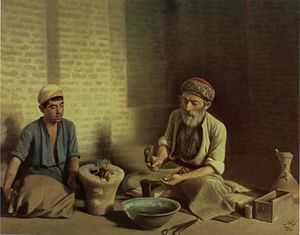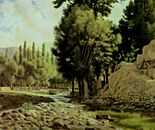Kamal-ol-molk
| Kamal-ol-molk | |
|---|---|
 | |
| Born |
Mohammad Ghaffari 1845 Kashan, Iran |
| Died |
August 18, 1940 Nishapur, Iran |
| Nationality | Iranian |
| Known for | Painting |


Mohammad Ghaffari (1845 - 18 August 1940), better known as Kamal-ol-Molk (also Kamal-al-Molk), was an Iranian painter and part of the Ghaffari family in Kashan.
Biography
Mohammad Ghaffari, better known as Kamal-ol-Molk, born in Kashan in 1848,[1] to a family greatly attached to art, and undoubtedly one of the most eminent artists in Iran, tracing their origins back to notable painters during the reign of Nader Shah.[1] Kamal's uncle, Mirza Abolhassan Khan Ghaffari, known as Sanee-ol-Molk, a 19th-century celebrated painter, was unrivalled in watercolor portraits. His father, Mirza Bozorg Ghaffari Kashani, was the founder of Iran's painting school and a famous artist as well. His brother, AbuTorab Ghaffari, was also a distinguished painter of his time. Mohammad developed an interest in calligraphy and painting at a young age. In his childhood eagerness, he drew charcoal sketches on the walls of his room. Some of the sketches he drew in that very house may amazingly, still be visible.
Upon completion of his primary education, Mohammad moved to Tehran. To further his studies, he registered in Dar-ul-Funun School, a modern institute of higher learning in Persia, where he studied painting with Mozayyen-od-Doleh, a well-known painter who had visited Europe and studied Western art. He studied there for a period of three years. In his school days, the young Ghaffari was given the name Mirza Mohammad Kashi. In this short period of education he was able to attract public attention to himself as a talented artist.
In his visits to Dar-ol-Fonoon, Naser al-Din Shah Qajar came to know Mohammad Ghaffari and, having observed his talent, he invited him to the court. Mohammad did his best to perfect his technique. Noticing his mastery in painting, Nasereddin Shah gave him the title "Kamal-ol-Molk (Perfection on Land)."
During the years he stayed at Naser al-Din Shah Qajar's court, Kamal-ol-Molk created some of his most significant works. The paintings he did in this period, which lasted up until the assassination of Nasereddin Shah, were portraits of important people, landscapes, paintings of royal camps and hunting grounds, and different parts of royal palaces.
In this busiest period of Kamal-ol-Molk's artistic life, he created over 170 paintings. Unfortunately, most of these paintings have either been destroyed or taken abroad. The works he created in this period indicate his desire to discover the laws of oil painting. He advanced so much that he even acquired laws of perspective by himself and applied them to his works. His mastery in the delicate use of a brush was well as bright and lively colors distinguished him from his contemporaries.
Visit to Europe
Following Naser al-Din Shah Qajar's death, Kamal-ol-Molk found it impossible to work under his son, Mozaffar ad-Din Shah Qajar. Therefore, he set out for Europe in 1898, at the age of 47 to improve his art.[1] Once there, he had discussions with distinguished European artists on style and technique, and copied some of Rembrandt's works, including "Self Portrait", "Jonah", and "Saint Matthew". Kamal-ol-Molk visited most of Europe's museums and closely studied the works of some well-known artists such as Raphael, Titian, and adapted and altered some of their works. He stayed in Europe for about four years. In 1902, he returned to Iran.
Migration to Iraq
The increasing pressure on Kamal-ol-Molk, originating in Mozaffar ad-Din Shah Qajar's court, left him no option but to leave his country for Iraq, in spite of all the affection he felt for Iran. The visits he made to the holy cities in Iraq inspired his work at this time. "Karbala-ye-Moalla Square", and "Baghdad Jewish Fortune Tellers" are two of his most magnificent works of this period.
With the advent of the Constitutional Movement, after a two-year stay in Iraq, Kamal-ol-Molk returned to Iran and joined the Constitutionalists because of the hatred he had developed towards Mazaffareddin Shah's government. Portraits like "Commander Asa'd Bakhtiari" and "Azad-ol-Molk" signify this period.
Kamal-ol-Molk Art School

The post-Constitutional Movement era of Persia brought about a new atmosphere for the artist. The Constitutionalists were cultured and appreciated art more than did their predecessors, thus respect for Kamal-ol-Molk and his works increased.
The master established Sanaye Mostazrafeh Art School, better known as Kamal-ol-Molk Art School, pursued his artistic career and steadied a new style in Iranian art. The School's goal was to find new talents, embrace them and educate them in the best possible way. Kamal-ol-Molk did not confine himself to painting. Rather, he introduced other arts and crafts such as carpet weaving, mosaic designing, and woodwork to his school in order to revive the dying fine arts. In addition to teaching art, through his kind behavior he also taught students love, morals and humanity. Many a time he stayed late at school, teaching. He even allotted a portion of his monthly payment to poor students.
Works

The Egyptian man is an oil on cotton duck. It was painted by Kamal-ol-molk in 1898 and features an Egyptian man removing one of his shoes. The painting is housed at Museum of Islamic Consultative Assembly in Tehran, Iran. Its dimensions are 54.5 cm × 27.5 cm (21.5 in × 10.8 in).
Death
Kamal-ol-Molk died in Nishapur, Iran, in 1940. Mournful people, especially family and closely related friends, marched his body next to the tomb of Sufi poet, Attar.
Gallery
-

Painting of Vosough od-Dowleh
-

The Azod al-Molk, 1910
-

Painting of Ali-Qoli Khan Bakhtiari
-

Painting of Naser al-Din Shah Qajar
-

The Baqdadi goldsmith, 1901
-

The Damavand Village, 1915
-
The Kamal-ol-molk profile portrait, 1925
-
The spring hall of Golestan Palace, 1889
-

Beggar Girls, painting by Kamal-ol-molk in 1889
-
_-_Petites_Mendiantes_(1880).jpg)
Petites Mendiantes by William-Adolphe Bouguereau, 1880
References
- ↑ 1.0 1.1 1.2 "KAMĀL-AL-MOLK, MOḤAMMAD ḠAFFĀRI, A. Ashraf with Layla Diba, '''Encyclopaedia Iranica'''". Iranicaonline.org. Retrieved 2014-01-21.
External links
| Wikimedia Commons has media related to Kamal-ol-molk. |
- Kamal ol molk on Caroun.com
- Ghaffari Clan website
- Panoramic Images of Kamal Tombs Neyshabur Day
- Biography and works of Kamal-ol-molk (in Persian language)
- Biography and works of Kamal-ol-molk (in Persian language)
|

